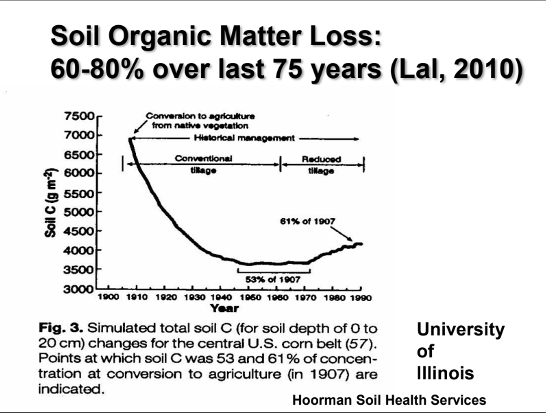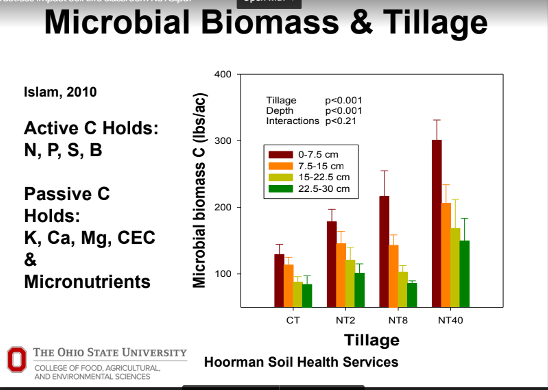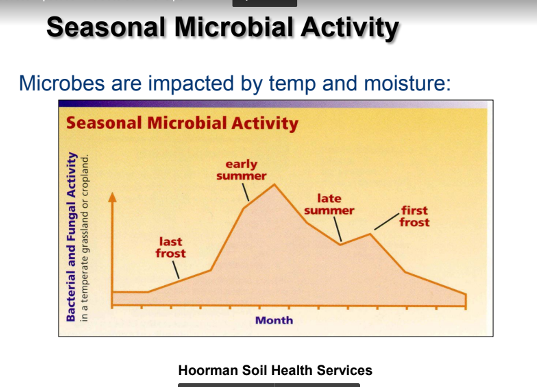Jim Hoorman, who studied Environmental Sciences at Ohio State University and currently owns Hoorman Soil Health Services in Jenera, Ohio, says soil has lost 60-80% of organic matter in the last 75-100 years. But no-tillers — and especially those using cover crops — likely see their soil organic matter increasing.
More and more information is surfacing, including findings from a 2018 study from the University of Illinois, to confirm the benefits of no-till operations compared to traditional full-till farming methods.

SOIL DECLINES. Over the last 75 years, soil organic matter has decreased by 60-80%, but practices like no-till and crop rotation are starting to reverse that trend.
Hoorman says the secret is having a crop or cover crop in the ground year round.
“Live roots is what it’s all about,” Hoorman says. “You have to have live roots in the soil to increase your fertility. That will make the soil’s nutrients available.”
Benefits of Crop Rotation
To determine the overall benefits of crop rotation, the University of Illinois established two experimental sites to evaluate four rotation methods:
- Continuous corn
- Continuous soybean
- A corn and soybean rotation
- A corn, soybean and wheat rotation
4 Principles that Conserve & Support High-Functioning Soils
1. Minimize Soil Disturbance
2. Maximize Surface Cover
3. Maximize Continuous Living Roots
4. Maximize Biodiversity
In addition to confirming that over-tilling can remove beneficial carbon and nitrogen (N), resulting in a negative impact to the soil’s microbes and microbial community, the study also yielded another valuable find — proper crop rotation can boost soil organic matter dynamics. Researchers also discovered:
- The corn-soybean-wheat rotation increased the soil’s organic carbon content compared to the continuous soybean crop.
- The continuous soybean crop reduced total N levels compared to other rotations.
- Levels of soil organic carbon and total N were 7% higher in no-till fields compared to full tillage fields.
- Overall rotation methods did not affect microbial biomass carbon and N.
- Tillage reduced microbial biomass N by 10-20 centimeters compared to no-till fields.
Despite the lack of sensitivity of microbial biomass, changes in the soil organic carbon and total nitrogen show how much proper rotation and tillage management affect soil organic matter dynamics. Including crops with higher carbon and N residues — coupled with no-till, minimal tillage and proper rotational practices — supports higher carbon and N content in the top 20 centimeters of the soil. Hoorman says add a cover crop to keep the soil protected and active year-round, and focusing on microbial health is equally as important as efficient rotation methods.

MAKING GAINS. Including crops with higher carbon and nitrogen residues coupled with proper no-till and crop rotation practices can increase carbon and nitrogen content in the top 20 centimeters of the soil.
Feeding the Microbes
“Almost all the soil’s nutrients go through microbes before reaching the plant,” Hoorman says. “Microbes need to be fed.”
According to PennState Extension, most soil microbes include fungi, bacteria, archaea, protozoa or viruses. Beneficial soil microbes carry out important functions, such as cycling nutrients, breaking down crop residue and stimulating plant growth. Proper microbial management combined with microbial community management — which includes earthworms, insects and plant roots — not only helps you achieve more holistic practices, but it can also increase the profitability of your crop and overall operation.
Microbes process 90% of the energy in soil where live plants already grow. With proper management practices, a no-tiller could have 1,000-2,000 times more microbes, and every one of those microbes is a soluble bag of fertilizer.
“I often ask, ‘Why are we fertilizing the corn and the soybeans when we should be fertilizing the microbes?’” Hoorman says. “After all, they’re the ones doing all the work.”
Hoorman says if no-tillers want to reduce their synthetic fertilizer use, they need to increase the soil’s microbes. That can be achieved through consistent live roots in fields as well as proper microbial management.
How Crop Rotation Affects Microbes
On a corn-soybean rotation, a no-tiller may have crops on the field 4-5 months of the year, so Hoorman suggests putting another crop out there the rest of the year.
“Even if you’re not making money off that third crop, you’re investing in your soil’s fertility and in the microbes that are producing better soil for the following year,” he says. “With today’s price on N, phosphorus and micronutrients, that can be a huge payoff.”
Most crops will give anywhere from 20-45% of their total carbohydrates to feed microbes. Not only can plants absorb N, nitrate and ammonium, but they can also collect amino acids and full proteins through the tips of their growing roots. This is called rhizophagy. To do this, roots lose their cell wall and absorb these elements. Then they inject amino acids and proteins back into the soil and form a new cell wall. These amino acids and proteins can be reabsorbed several times over.
“Typically, 10% of these elements don’t make it back into the soil,” Hoorman says. "But that’s okay because they give us plant growth hormones that make those roots proliferate and increase plant growth.”
Hoorman says the worst crop rotation strategy is having only one annual crop because having a diversity of crops means having a diversity of microbes.
“All corn isn’t as bad as all soybeans,” Hoorman says. “With only soybeans, we generally see yields get worse and worse. I know some farmers who produce soybeans after soybeans after soybeans, but they’ll rotate — soybeans, cereal rye, soybeans, barley and then back to soybeans. This helps break up pest and disease cycles, ensuring that no one microbe becomes dominant, which can promote disease.”

STILL BUFFERING. Cover crops act as a barrier to protect soil microbes, especially in adverse conditions like downpours, cold winter months and hot summer days.
Other Advantages to Year-Round Live Roots
In addition to feeding microbes and increasing soil organic matter, proper crop rotation and soil management practices can offer these additional benefits:
- Healthy soils increase water absorption and retention. Unhealthy soils can have higher surface tension, making it harder for water to penetrate deep into the soil. Excessive rain on heavily tilled or unhealthy soils can cause macropores to seal over, which decreases absorption and causes runoff and erosion. “Good soil that has good structure can absorb more rain and keep it there,” Hoorman says.
- Cover crops provide a soil buffer. “Microbes and your microbial community like about 75-80% moisture,” Hoorman says. “That’s what the earthworms like — temperatures around 80 degrees F, which is also ideal for most of our microbes.” Hot summers or frigid winters can decrease your soil’s microbial biomass, but Hoorman says no-tillers can temper soil organic matter with a cover crop buffer. A healthy cover crop will provide a layer of protection and insulation, retaining a more consistent temperature and holding moisture in the soil to keep microbes healthier.
- Live crops encourage rain. “We now know there’s about 120-some species of microbes that actually help it rain,” Hoorman says. However, because of trade winds, a no-tiller's own farm may not always experience the benefits from your consistently live crops. “If we get enough farmers planting live crops, we won’t have as many torrential rains as we used to because microbes in the atmosphere will help regulate rainfall.”
Related Content
[Podcast] Boosting Your Bottom Line with Humates & Mineral Nutrition
Are Soil Inoculants Useful in No-Till Systems?
Biological Nutrient Uptake Observed in Regen Soils






Post a comment
Report Abusive Comment